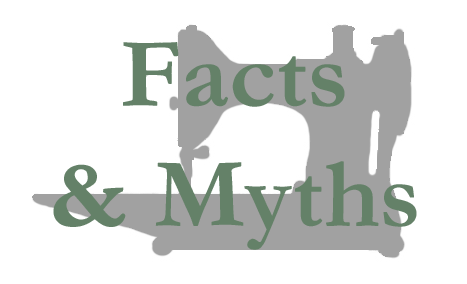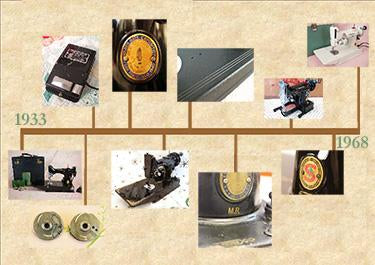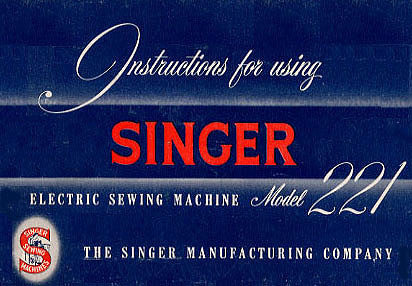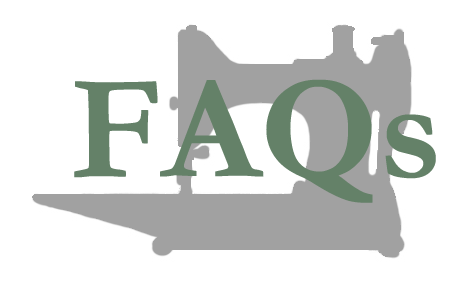Taxes and discounts calculated in checkout.
BROWSE SCHOOLHOUSE
Facts & Myths
Singer Featherweight Factsand Some Myths Exposed by Graham Forsdyke Singer Featherweight machines were produced in black, beige/tan and white/green (what the company officially called Pale Turquoise). There were no red, blue or any other colour machines although many have been repainted in later life and new decals added. Black 221 machines were produced at Elizabethport, New Jersey, and at Clydebank, Scotland. Beige/tan machines were produced at Clydebank and at St John's, Canada. White/Green machines were produced only at Clydebank. 222 Freearm Featherweights were produced only at Clydebank. Many UK-built machines were sent across the Atlantic to have motors fitted in...
Timeline History of the Singer Featherweight
From 1933 to 1969, this timeline provides a detailed history of the Singer Featherweight 221, 222 and all the details surrounding this Singer Sewing Machine. 1933:On October 3, 1933, Singer commissioned the first batch of 10,000 model 221 sewing machines, marketing them as the Singer Featherweight. Experimenting with the design and aesthetics of this new model, some of the distinctions varied, so do not be surprised if you find some subtle changes from machine to machine within this first batch. The first 200 machines (approximately) had these distinctions: Photo Courtesy of Rob Andre' Stevens 0.6 amp foot controllers different bobbin...
Singer Featherweight Advertisements
There were many Singer Featherweight advertisements over the years and we hope to share quite a few of those with you here. If you happen to have a unique one that you do not see listed, please contact us, because we would like to feature it for all to enjoy in the Featherweight Community. Singer Featherweight 221 Advertising Leaflets Singer Featherweight 222K Advertising Leaflets Singer Featherweight 221J and 221K Advertising Leaflets This advertisement features the Tan Featherweight at the centerfold, including an originally advertised price of $132.50.
The Tan Featherweight 221J or 221K
This is one of the first "colored" Featherweights (besides "Pale Turquoise") that Singer produced besides the traditional black Featherweight. It has a few notable differences which will be noted in the photographs below. Mechanically, the tan Featherweight is identical to the black. The 'J' after the model 221 simply means the machine was manufactured in St. John's, Quebec, Canada. The 'K' means it was made in Kilbowie, Scotland (Great Britain). Most tan Featherweights have the 221J plate, but a few are noted as having the 221K model plate. They would have included a manual with the reference of either 221J...
Identify Your Manual
The Various Featherweight Manuals Throughout the years that Featherweights were produced, the Singer company produced some manual variations. The principal handbooks given with machines are shown here. Above Left: This manual is the standard handbook supplied with US-built Featherweight Machines.(This particular one has a copyright date of 1941.) Above Right: This manual-style was supplied with UK-built Featherweight Machines. It was also printed in the UK. If your manual is like those two above, you can determine the date of your manual by looking in the upper left corner. The number in parentheses is indicative of a month and...
Singer Featherweight Blackside Finish
The “Blackside Featherweight” can be an obscure find unless you know what to look for, because it may just look like a regular Featherweight with only a few darker looking parts. However, there are some important distinctions, so you don't want to presume that just because a Featherweight has a blackside part, that it falls into the collectible “Blackside Featherweight” category. Proceed cautiously when purchasing one. Before we discuss “blackside” specifically, we must delve into a bit of history from WWII. As you know, there were shortages and rations of certain metals and alloys to aid with the war...
Singer Wrinkle (Crinkle) Featherweight 221
Serial Number: AF589*** indicates commission date of August 15, 1940 This uniquely finished Featherweight has been most commonly referred to as the “Crinkle” Featherweight or sometimes called a “Matte Finish” Featherweight. However, we would like to dispel that descriptive adjective with the bona fide name that Singer gave it originally. The official name for this particular finish is called “Wrinkle”. And, as you can see in the photograph below, taken by a fellow Featherweight historian, that the term is indeed correct. Photos Courtesy of JJ & Leo of The Featherweight Factory So, from here on out, it will...
Singer Featherweight Red 'S' Badge
The Red S Badged Featherweight "I hear a lot about the Red 'S' Featherweight - what is it? and what does it look like?"This is a question we receive once in awhile and it is a good one!A Red 'S' Badge on a Singer Featherweight A Red 'S' badged black Featherweight has become one more novelty for collectors and may add a little bit more value to a machine, assuming condition and inclusions are the same as a regular badged Featherweight. From 1959 to 1961, Singer changed the oval badges on the black Singer Featherweight from the classic shuttle and spool...
The White Featherweight 221K
Produced from the mid to late 1960's in Kilbowie Scotland, this machine was something fresh and new to the Singer Featherweight market. The official Singer color was called "Pale Turquoise", but the machine was often times more white or pale green in appearance depending on the casting light. For ease of reference, naming it the White Featherweight has become common place and known throughout the world. So, whether you hear of a pale or celery green, pale turquoise or white Featherweight, they are all in reference to this same model machine. With its interior toothed belt, it was considered in...
Singer Featherweight FAQs
A collection of frequently asked questions surrounding the Singer Featherweight... from "Is my machine a Featherweight?" to "What is my Featherweight worth?" to "I just got a Featherweight, now what do I do?"... and MORE! This set of questions will be a great place to begin if you are wanting to briefly familiarize yourself with some common inquiries.
- « Previous Previous page
- Page 4 of 4













